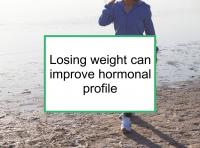High levels of circulating sex hormones are associated with increased breast cancer risk. Both diet and exercise can influence these levels, especially when they lead to weight loss in overweight or obese women. Now a new study has assessed the relative contributions of calorie restriction and exercise to a more favorable hormonal profile.
Circulating sex hormones are associated with breast cancer risk
Elevated levels of estrogens and androgens are associated with increased risk of breast cancer. One study reported that women in the top fifth of individual estrogen or androgen levels had approximately twice the risk of postmenopausal breast cancer as those in the lowest fifth.
Circulating estradiol levels have been shown to be associated with cancer-related gene expression of estrogen receptor positive (ER+) tumors. However, high circulating sex hormone levels increase risk of both hormone receptor positive and hormone receptor negative breast cancer.
Overweight women tend to have higher levels of certain sex hormones (including estradiol, free estradiol, estrone, estrone sulfate, total testosterone, free testosterone, androstenedione, and dehydroepiandrosterone sulfate (DHEA sulfate)) than normal weight women, with the largest difference for free estradiol.
On the other hand, overweight women generally have lower levels of sex hormone binding globulin (SHBG), a compound that binds to testosterone and estradiol, thereby reducing breast cancer risk.
Both diet and exercise can influence hormone levels
Both diet and exercise can alter circulating hormone levels. Calorie restriction has been shown to reduce harmful hormone levels even in the absence of exercise. Exercise itself can lower hormone levels, especially estradiol, but is best combined with a diet abundant in vegetables and fruits. In fact, regular exercise plus a high quality diet can overcome the negative effects of obesity on breast cancer survival.
Calorie restriction has a stronger impact on hormones than exercise
The study referenced at the beginning of this news article was designed to compare the effects of calorie restriction, exercise, and the combination of the two on circulating sex hormones in overweight and obese postmenopausal women. To perform the study, the authors conducted a 12-month trial in which women were assigned to one of four groups: (1) reduced-calorie weight loss diet (diet group; 118 women); (2) moderate to vigorous aerobic exercise (exercise group; 117); (3) combined reduced-calorie diet and aerobic exercise (diet + exercise group; 117); or (4) non-intervention (control group; 87). Participants were aged 50 to 75 (average: 58), had a body mass index over 25.0 kg/m2 (average: 30.9), and were exercising fewer than 100 minutes per week at baseline. Women in the diet and diet + exercise groups lost an average of 10 percent of their starting weight.
The weight loss diet reduced estradiol by 16.2% compared to controls, whereas aerobic exercise reduced it by 4.9%, and the combination of diet and exercise reduced it by 20.3%. Free estradiol declined 21.4% as a result of diet and 26.0% as a result of diet + exercise. Diet reduced estrone by 9.6%, whereas exercise reduced it by 5.5%, and diet + exercise reduced it by 11.1%. Free testosterone declined 10.0% with diet and 15.6% with diet + exercise. SHBG increased 22.4% as a result of diet and 25.8% as a result of diet + exercise. Women with the most weight loss were found to have the greatest beneficial changes in estrogens and SHBG.
The authors conclude that weight loss significantly reduce circulating estrogens and free testosterone, supporting the hypothesis that weight loss can reduce breast cancer risk by lowering exposure to breast cancer biomarkers.
